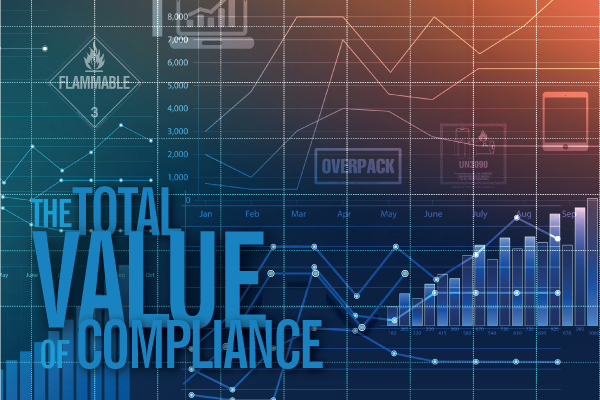 Why do you pursue Dangerous Goods compliance?
Why do you pursue Dangerous Goods compliance?
Take a moment before you answer, because the real reason may not be as obvious as you think. We’ve been asking hazmat professionals that question for years, and the answers have evolved. Today, nearly a quarter of companies in the DG supply chain pursue compliance because it’s a competitive advantage.
As that attitude has evolved, we’ve also heard DG pros say they’d like to make compliance a competitive advantage, but they don’t know how to make the case with their companies’ management.
That’s why we developed a new idea for the modern supply chain: total value of compliance.
What is total value of compliance?
First and foremost, total value of compliance (TVC) is a new way of thinking about supply chain operations that views DG compliance as not just a cost of doing business, but also as a value-added component that contributes to profitability.
The higher your TVC, the more profitable your operation can be.
TVC isn’t just a new business principle, though—it’s a framework for making it happen, building on three factors relevant to any business engaged in hazmat transport
- The costs of compliance. The actual cost of maintaining compliance throughout your supply chain
- The costs of non-compliance. The cost of errors or lapses in compliance
- The revenue opportunities of higher-level compliance. Opportunities for market leaders to differentiate, increase revenue and speed cash flows
We’ll take a closer look at each of these in future posts, but here’s a quick overview.
The costs of compliance
There’s no getting around it—you have to spend money to pursue Dangerous Goods compliance. But are you getting the most value out of those expenditures?
To answer that question, you need to consider more than just the costs of labels, placards, packaging, training and regulatory resources. Your true cost of compliance may also include:
- Personnel
- Hazmat-specific processes
- Supportive software and other technology
- Reporting and oversight
- Management
If these costs are hidden in fractured views across all your sites, verticals, channels, products and accounting reports, it’s hard to account for them all, let alone optimize them.
And then there’s the perpetual trade-off between price and productivity. Do you know if lower per-unit costs actually translate into more work?
You can’t calculate your costs of compliance by simply adding up your compliance-related purchases—you have to consider all aspects of cost to make the best decisions for your bottom line.
The costs of non-compliance
Another way to boost your TVC is by simply reducing the errors and gaps that result in non-compliance.
Some of those costs are obvious—civil penalties, customer fines and remediation for shipments that get flagged by inspectors. But compliance errors and gaps can trigger a domino effect of more expensive consequences:
- Carrier refusal of shipments
- Return shipping costs
- Disposal of materials from returned shipments
- Damage or contamination of trailers, tankers, containers or vehicles
- Incident reporting and cleanup costs
- Higher insurance premiums resulting from failed inspections or incidents
- Potential liability for damages or injuries
Don’t forget the bad publicity from a hazmat-related incident, or the negative impact non-compliance can have on customer loyalty. If a small infraction delays a critical shipment in customs, for example, what’s the likelihood of your customer turning to a competitor for the next shipment?
The revenue opportunities of higher-level compliance
Say superior compliance helps Company A achieve a 99% on-time delivery rate. Company B might consider 95% pretty good, but compared to Company A, they’re dropping the ball once every 25 deliveries.
Which company is more likely to gain new customers? Which company has a more potent brand?
Beyond making your organization a more valuable supply chain partner, superior compliance can actually open the door to new revenue sources:
- New products aligned with regulatory standards from day one
- Popular products that other companies, less familiar with Dangerous Goods, may avoid
- Joint ventures and other collaborative initiatives
- New customers and supply chain partners
This facet of TVC—driving higher revenues with superior compliance—is where today’s most advanced shippers turn hazmat compliance into a competitive advantage.
Read more about total value of compliance
We’ll be writing more about TVC later this month and throughout 2019, with specific guidelines to help you improve your operation in all three aspects of the TVC framework.
Meanwhile, for more detail about the TVC concept and how you can apply it, download the Total Value of Compliance Technical Brief today.
You’ll be on your way to a whole new answer to the question, “Why do you pursue Dangerous Goods compliance?”
Labelmaster is a full-service provider of goods and services for hazardous materials and Dangerous Goods professionals, shippers, transport operators and EH&S providers. See our full line of solutions at labelmaster.com.



I take it as a daily challenge to be and stay in compliance. I convey this to our customers and it also helps their business as well. With our diligence, our customers rely on us for their specific concerns and questions which makes us a great partner to them and it helps with the bottom line as when it comes to new business they think of us first